Ameeta Agrawal
SymCode: A Neurosymbolic Approach to Mathematical Reasoning via Verifiable Code Generation
Oct 29, 2025Abstract:Large Language Models (LLMs) often struggle with complex mathematical reasoning, where prose-based generation leads to unverified and arithmetically unsound solutions. Current prompting strategies like Chain of Thought still operate within this unreliable medium, lacking a mechanism for deterministic verification. To address these limitations, we introduce SymCode, a neurosymbolic framework that reframes mathematical problem-solving as a task of verifiable code generation using the SymPy library. We evaluate SymCode on challenging benchmarks, including MATH-500 and OlympiadBench, demonstrating significant accuracy improvements of up to 13.6 percentage points over baselines. Our analysis shows that SymCode is not only more token-efficient but also fundamentally shifts model failures from opaque logical fallacies towards transparent, programmatic errors. By grounding LLM reasoning in a deterministic symbolic engine, SymCode represents a key step towards more accurate and trustworthy AI in formal domains.
Correct-Detect: Balancing Performance and Ambiguity Through the Lens of Coreference Resolution in LLMs
Sep 17, 2025Abstract:Large Language Models (LLMs) are intended to reflect human linguistic competencies. But humans have access to a broad and embodied context, which is key in detecting and resolving linguistic ambiguities, even in isolated text spans. A foundational case of semantic ambiguity is found in the task of coreference resolution: how is a pronoun related to an earlier person mention? This capability is implicit in nearly every downstream task, and the presence of ambiguity at this level can alter performance significantly. We show that LLMs can achieve good performance with minimal prompting in both coreference disambiguation and the detection of ambiguity in coreference, however, they cannot do both at the same time. We present the CORRECT-DETECT trade-off: though models have both capabilities and deploy them implicitly, successful performance balancing these two abilities remains elusive.
Towards Personalized Explanations for Health Simulations: A Mixed-Methods Framework for Stakeholder-Centric Summarization
Sep 04, 2025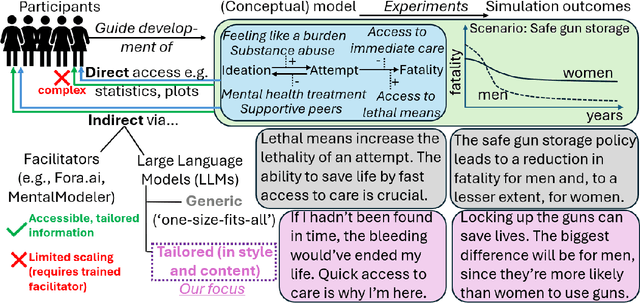
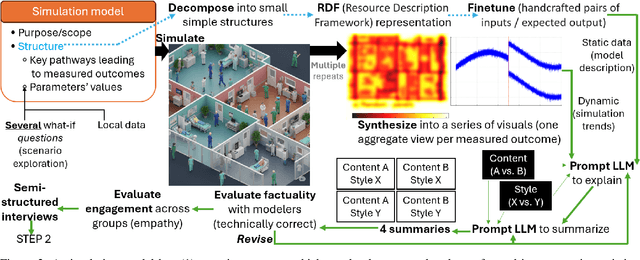
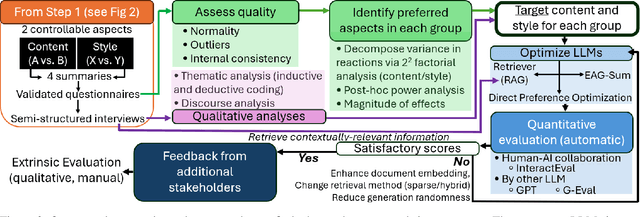
Abstract:Modeling & Simulation (M&S) approaches such as agent-based models hold significant potential to support decision-making activities in health, with recent examples including the adoption of vaccines, and a vast literature on healthy eating behaviors and physical activity behaviors. These models are potentially usable by different stakeholder groups, as they support policy-makers to estimate the consequences of potential interventions and they can guide individuals in making healthy choices in complex environments. However, this potential may not be fully realized because of the models' complexity, which makes them inaccessible to the stakeholders who could benefit the most. While Large Language Models (LLMs) can translate simulation outputs and the design of models into text, current approaches typically rely on one-size-fits-all summaries that fail to reflect the varied informational needs and stylistic preferences of clinicians, policymakers, patients, caregivers, and health advocates. This limitation stems from a fundamental gap: we lack a systematic understanding of what these stakeholders need from explanations and how to tailor them accordingly. To address this gap, we present a step-by-step framework to identify stakeholder needs and guide LLMs in generating tailored explanations of health simulations. Our procedure uses a mixed-methods design by first eliciting the explanation needs and stylistic preferences of diverse health stakeholders, then optimizing the ability of LLMs to generate tailored outputs (e.g., via controllable attribute tuning), and then evaluating through a comprehensive range of metrics to further improve the tailored generation of summaries.
MFTCXplain: A Multilingual Benchmark Dataset for Evaluating the Moral Reasoning of LLMs through Hate Speech Multi-hop Explanation
Jun 23, 2025Abstract:Ensuring the moral reasoning capabilities of Large Language Models (LLMs) is a growing concern as these systems are used in socially sensitive tasks. Nevertheless, current evaluation benchmarks present two major shortcomings: a lack of annotations that justify moral classifications, which limits transparency and interpretability; and a predominant focus on English, which constrains the assessment of moral reasoning across diverse cultural settings. In this paper, we introduce MFTCXplain, a multilingual benchmark dataset for evaluating the moral reasoning of LLMs via hate speech multi-hop explanation using Moral Foundation Theory (MFT). The dataset comprises 3,000 tweets across Portuguese, Italian, Persian, and English, annotated with binary hate speech labels, moral categories, and text span-level rationales. Empirical results highlight a misalignment between LLM outputs and human annotations in moral reasoning tasks. While LLMs perform well in hate speech detection (F1 up to 0.836), their ability to predict moral sentiments is notably weak (F1 < 0.35). Furthermore, rationale alignment remains limited mainly in underrepresented languages. These findings show the limited capacity of current LLMs to internalize and reflect human moral reasoning.
Who Relies More on World Knowledge and Bias for Syntactic Ambiguity Resolution: Humans or LLMs?
Mar 13, 2025Abstract:This study explores how recent large language models (LLMs) navigate relative clause attachment {ambiguity} and use world knowledge biases for disambiguation in six typologically diverse languages: English, Chinese, Japanese, Korean, Russian, and Spanish. We describe the process of creating a novel dataset -- MultiWho -- for fine-grained evaluation of relative clause attachment preferences in ambiguous and unambiguous contexts. Our experiments with three LLMs indicate that, contrary to humans, LLMs consistently exhibit a preference for local attachment, displaying limited responsiveness to syntactic variations or language-specific attachment patterns. Although LLMs performed well in unambiguous cases, they rigidly prioritized world knowledge biases, lacking the flexibility of human language processing. These findings highlight the need for more diverse, pragmatically nuanced multilingual training to improve LLMs' handling of complex structures and human-like comprehension.
Multilingual Relative Clause Attachment Ambiguity Resolution in Large Language Models
Mar 04, 2025



Abstract:This study examines how large language models (LLMs) resolve relative clause (RC) attachment ambiguities and compares their performance to human sentence processing. Focusing on two linguistic factors, namely the length of RCs and the syntactic position of complex determiner phrases (DPs), we assess whether LLMs can achieve human-like interpretations amid the complexities of language. In this study, we evaluated several LLMs, including Claude, Gemini and Llama, in multiple languages: English, Spanish, French, German, Japanese, and Korean. While these models performed well in Indo-European languages (English, Spanish, French, and German), they encountered difficulties in Asian languages (Japanese and Korean), often defaulting to incorrect English translations. The findings underscore the variability in LLMs' handling of linguistic ambiguities and highlight the need for model improvements, particularly for non-European languages. This research informs future enhancements in LLM design to improve accuracy and human-like processing in diverse linguistic environments.
The Impact of Model Scaling on Seen and Unseen Language Performance
Jan 10, 2025


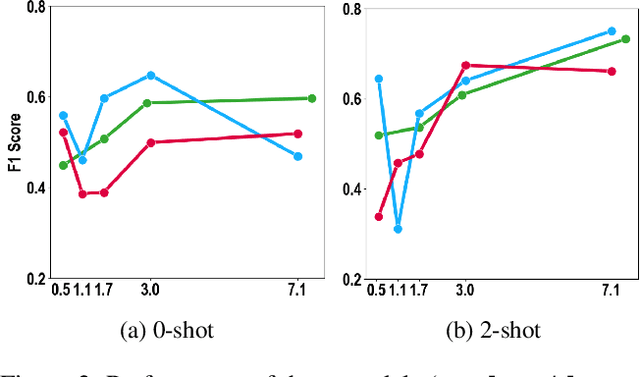
Abstract:The rapid advancement of Large Language Models (LLMs), particularly those trained on multilingual corpora, has intensified the need for a deeper understanding of their performance across a diverse range of languages and model sizes. Our research addresses this critical need by studying the performance and scaling behavior of multilingual LLMs in text classification and machine translation tasks across 204 languages. We systematically examine both seen and unseen languages across three model families of varying sizes in zero-shot and few-shot settings. Our findings show significant differences in scaling behavior between zero-shot and two-shot scenarios, with striking disparities in performance between seen and unseen languages. Model scale has little effect on zero-shot performance, which remains mostly flat. However, in two-shot settings, larger models show clear linear improvements in multilingual text classification. For translation tasks, however, only the instruction-tuned model showed clear benefits from scaling. Our analysis also suggests that overall resource levels, not just the proportions of pretraining languages, are better predictors of model performance, shedding light on what drives multilingual LLM effectiveness.
Advanced Machine Learning Techniques for Social Support Detection on Social Media
Jan 06, 2025
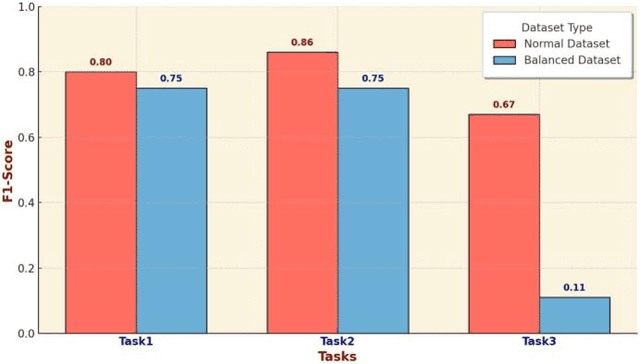

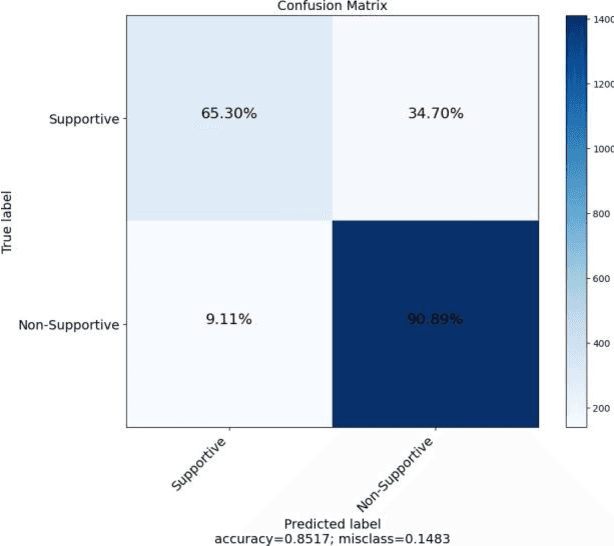
Abstract:The widespread use of social media highlights the need to understand its impact, particularly the role of online social support. This study uses a dataset focused on online social support, which includes binary and multiclass classifications of social support content on social media. The classification of social support is divided into three tasks. The first task focuses on distinguishing between supportive and non-supportive. The second task aims to identify whether the support is directed toward an individual or a group. The third task categorizes the specific type of social support, grouping it into categories such as Nation, LGBTQ, Black people, Women, Religion, and Other (if it does not fit into the previously mentioned categories). To address data imbalances in these tasks, we employed K-means clustering for balancing the dataset and compared the results with the original unbalanced data. Using advanced machine learning techniques, including transformers and zero-shot learning approaches with GPT3, GPT4, and GPT4-o, we predict social support levels in various contexts. The effectiveness of the dataset is evaluated using baseline models across different learning approaches, with transformer-based methods demonstrating superior performance. Additionally, we achieved a 0.4\% increase in the macro F1 score for the second task and a 0.7\% increase for the third task, compared to previous work utilizing traditional machine learning with psycholinguistic and unigram-based TF-IDF values.
Beyond Data Quantity: Key Factors Driving Performance in Multilingual Language Models
Dec 17, 2024Abstract:Multilingual language models (MLLMs) are crucial for handling text across various languages, yet they often show performance disparities due to differences in resource availability and linguistic characteristics. While the impact of pre-train data percentage and model size on performance is well-known, our study reveals additional critical factors that significantly influence MLLM effectiveness. Analyzing a wide range of features, including geographical, linguistic, and resource-related aspects, we focus on the SIB-200 dataset for classification and the Flores-200 dataset for machine translation, using regression models and SHAP values across 204 languages. Our findings identify token similarity and country similarity as pivotal factors, alongside pre-train data and model size, in enhancing model performance. Token similarity facilitates cross-lingual transfer, while country similarity highlights the importance of shared cultural and linguistic contexts. These insights offer valuable guidance for developing more equitable and effective multilingual language models, particularly for underrepresented languages.
Fair Summarization: Bridging Quality and Diversity in Extractive Summaries
Nov 13, 2024



Abstract:Fairness in multi-document summarization of user-generated content remains a critical challenge in natural language processing (NLP). Existing summarization methods often fail to ensure equitable representation across different social groups, leading to biased outputs. In this paper, we introduce two novel methods for fair extractive summarization: FairExtract, a clustering-based approach, and FairGPT, which leverages GPT-3.5-turbo with fairness constraints. We evaluate these methods using Divsumm summarization dataset of White-aligned, Hispanic, and African-American dialect tweets and compare them against relevant baselines. The results obtained using a comprehensive set of summarization quality metrics such as SUPERT, BLANC, SummaQA, BARTScore, and UniEval, as well as a fairness metric F, demonstrate that FairExtract and FairGPT achieve superior fairness while maintaining competitive summarization quality. Additionally, we introduce composite metrics (e.g., SUPERT+F, BLANC+F) that integrate quality and fairness into a single evaluation framework, offering a more nuanced understanding of the trade-offs between these objectives. This work highlights the importance of fairness in summarization and sets a benchmark for future research in fairness-aware NLP models.
 Add to Chrome
Add to Chrome Add to Firefox
Add to Firefox Add to Edge
Add to Edge